The Intel Xeon W-3175X Review: 28 Unlocked Cores, $2999
by Ian Cutress on January 30, 2019 9:00 AM ESTIntel’s Prebuilt Test System: A $7000 Build
How we receive test units for review has varied greatly over the years. The company providing the review sample has a range of choices and hands-on solutions.
For a regular run of the mill launch, such as Kaby Lake/Coffee Lake/Coffee Lake gen 2, which are second generation launches on the same mature platform as the last generation, we get just the CPU and a set of ‘expected test result notes’ to help guide our testing. The reviewers are expected to know how to use everything and the vendor has confidence in the reviewers analysis. This method allows for the widest range of sampling and the least work at the vendor level, although relies on the journalist to have the relevant contacts with motherboard and memory companies as well as the ability to apply firmware updates as needed.
For important new launches, such as Ryzen and AM4, or Threadripper and TR4, or Skylake-X and X299, the vendor supplied the CPU(s), a motherboard, a memory kit, and a suitable CPU cooler. Sometimes there’s a bit of paper from the FAE tester that confirmed the set worked together over some basic stress tests, but it puts less work in the hands of the reviewer knowing that none of the kit should be dead on arrival and it should at least get to the OS without issue.
For unique launches, where only a few samples are being distributed, or there is limited mix-and-match support ready for day one, the option is the full system sample. This means case, motherboard, CPU, CPU cooler, memory, power supply, graphics card, and storage are all shipped as one, sometimes directly from a system integrator partner, but with the idea that the system has been pre-built, pre-tested, and ready to go. This should give the reviewer the least amount of work to do (in practice it’s usually it’s the opposite), but it puts a lot of emphasis on the vendor to plan ahead, and limits the scope of sampling. It also the most expensive for the vendor to implement, but usually the tradeoff is perceived as worth it.
Usually we deal with options one or two for every modern platform to date. Option three is only ever taken if the CPU vendor aims to sell the processor to OEMs and system integrators (SI) only. This is what Intel has done with the Xeon W-3175X, however they built the systems internally rather than outsourcing. After dispatch from the US to the UK, via the Netherlands, an 80 lb (36 kg) box arrived on my doorstep.
This box was huge. I mean, I know the motherboard is huge, I’ve seen it in the flesh several times, but Intel also went and super-sized the system too. This box was 33 inches tall (84 cm), and inside that was a set of polystyrene spacers for the actual box for the case, which again also had polystyrene spacers. Double spacey.
Apologies for taking these photos in my kitchen – it is literally the only room in my flat in which I had enough space to unbox this thing. Summer wanted to help, and got quite vocal.
The case being used is the Anidees AI Crystal XL AR, listed on the company’s website as ‘all the space you need for your large and heavy loaded components’, including support for HPTX, XL-ATX, E-ATX, and EEB sized motherboards, along with a 480mm radiator on top and a 360mm radiator on front, and comes with five 120mm RGB fans as standard. It’s a beast, surrounded with 5mm tempered glass on every side that needs it.
The case IO has a fan control switch (didn’t work), two audio jacks, an LED power button, a smaller LED reset button, two USB 3.0 Type-A ports, and two USB 2.0 Type-A ports. These were flush against the design making for a very straight edged design.
This picture might show you how tall it is. Someone at Intel didn’t install the rear IO plate leaving an air gap, but actually the system airflow was designed for the rear of the chassis to be the intake and the front of the chassis to be the exhaust. There are 10 PCIe slot gaps here, along with two vertical ones for users that want to mount in that way. There is sufficient ‘case bezel’ on all sides, unlike some smaller cases that minimize this.
Users may note the power supply has an odd connector. This is a C19 connecter usually used for high-wattage power supplies, and strapped to the box Intel had supplied a power cable.
This bad boy is thick. Ignoring the fact that this is a US cable and the earth pin is huge to the extent that it would only fit in one of my adaptors and even nudging the cable caused the machine to restart so I had to buy a UK cable that worked great, this unit is designed for the low voltage US market it seems. It has to be able to deliver up to 13A of current on a 120V line, or potentially more, so is built as such. With this it is obviously recommended that no socket extenders are used and this goes directly into the wall.
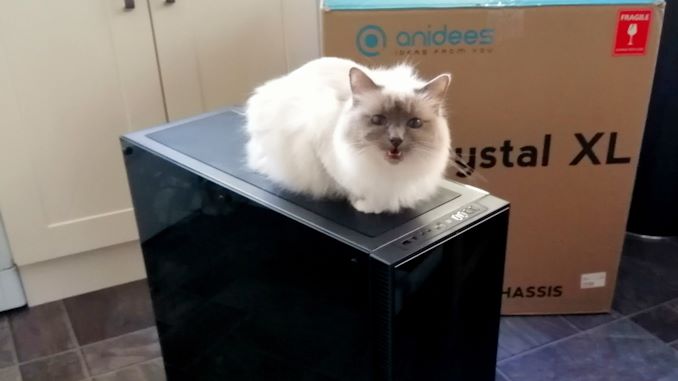
About to take the side panels off. This little one wants to play.
Both of the tempered glass side panels are held on by nine thumb screws each, which sit on rubber stands on the inside of the case. Unscrewing these was easy enough to do, however it’s one of the slowest ways to open a case I’ve ever come across.
Now inside the system at hand. The LGA3647 socket holds the Xeon W-3175X processor, which is capped with an Asetek 690LX-PN liquid cooler specifically designed for the workstation market. This goes to a 360mm liquid cooling radiator, paired with three high power (I’m pretty sure they’re Delta) fans that sound like a jet engine above 55ºC.
Intel half populated the memory with 8GB Samsung DDR-2666 RDIMMs, making for a total of 48 GB of memory, which is likely going to be the lowest configuration one of these CPUs will ever be paired with. The graphics card is a GIGABYTE GTX 1080, specifically the GV-N1080TTOC-8GD, which requires one 8-pin power connector.
For the motherboard, the ASUS Dominus Extreme, we’ve detailed it in previous coverage, however it’s worth to note that the big thing at the top of this motherboard is actually the heatsink for the 32-phase VRM. It’s a beast. Here is an ASUS build using this motherboard with a liquid cooler on the CPU and VRM:
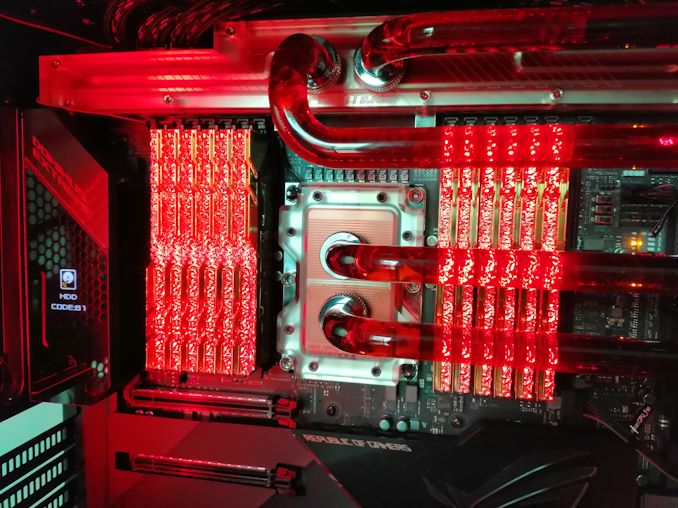
The build at ASUS’ suite at CES 2019
There’s a little OLED display to the left, which as a full color display useful for showing BIOS codes and CPU temperatures when in Windows. When the system is off, it goes through a short 15 second cycle with the logo:
I’m pretty sure users can put their own gifs (perhaps within some limits) on the display during usual run time using ASUS software.
The rear of the case is quite neat, showing part of the back of the motherboard and the fan controller. At the bottom we have an EVGA 1600W T2 80PLUS Titanium power supply, which is appropriate for this build. Unfortunately Intel only supplied the cables that they actually used with the system, making it difficult to expand to multiple GPUs, which is what a system like this would ultimately end up with.
For storage, Intel provided an Optane 905P 480GB U.2 drive, which unfortunately had so many issues with the default OS installation (and then failing my own OS installation) that I had to remove it and debug it another day. Instead I put in my own Crucial MX200 1TB SATA SSD which we normally use for CPU testing and installed the OS directly on that. ASUS has a feature in the BIOS that will automatically push a software install to initiate driver updates without the need for a driver DVD – this ended up being very helpful.
Overall, the system cost is probably on the order of $7000:
| Intel Reference System | ||
| Item | List Price | |
| CPU | Intel Xeon W-3175X | $2999 |
| CPU Cooler | Asetek 690LX-PN | $260 |
| Motherboard | ASUS Dominus Extreme | $1500 ? |
| Memory | 6 x 8GB Samsung DDR4-2666 RDIMM | $420 |
| Storage | Intel Optane 905P 480 GB U.2 | $552 |
| Video Card | GIGABYTE GTX 1080 OC 8GB | $550 |
| Chassis | Anidees AI Crystal XL AR | $300 |
| Power Supply | EVGA 1600W T2 Titanium | $357 |
| Total | $6938 | |
However, this is with a minimum amount of memory, only one GTX 1080, and a mid-sized U.2 drive. If we add in liquid cooling, a pair of RTX 2080 Ti graphics cards, 12x16GB of DDR4, and some proper storage, the price could easily creep over $10k-$12k, then add on the system builder additions. The version of this system we saw at the Digital Storm booth at CES, the Corsa, was around $20k.


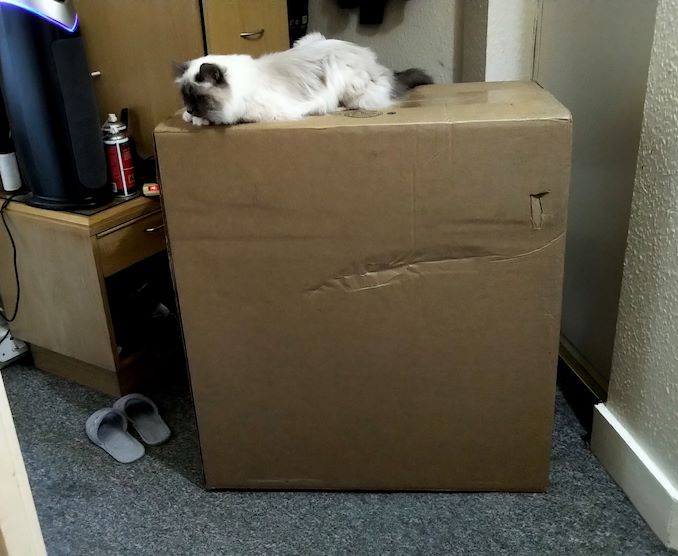
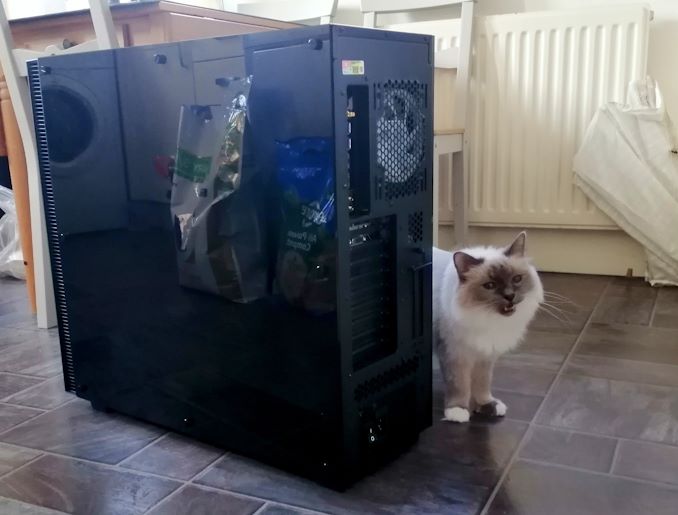
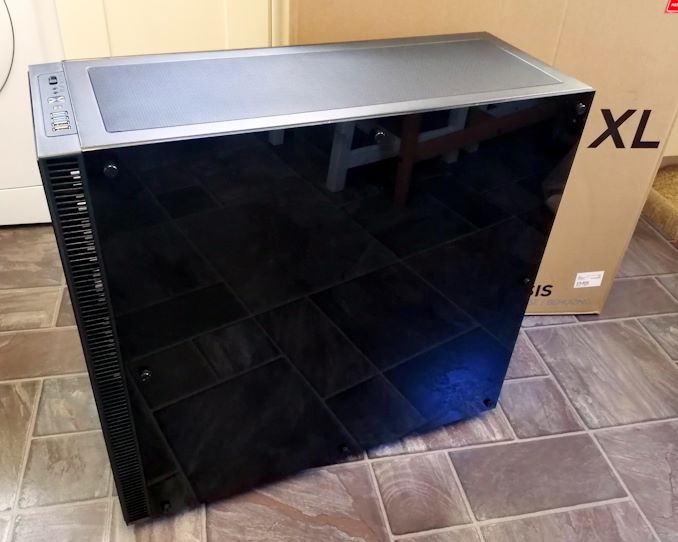
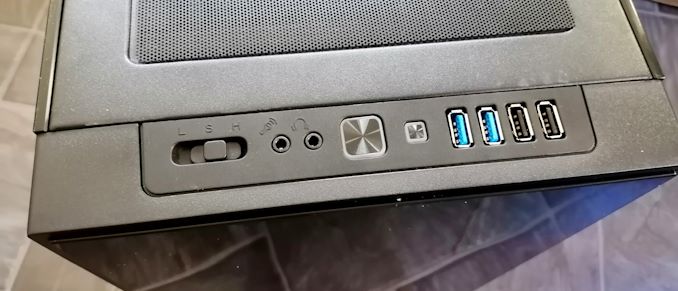
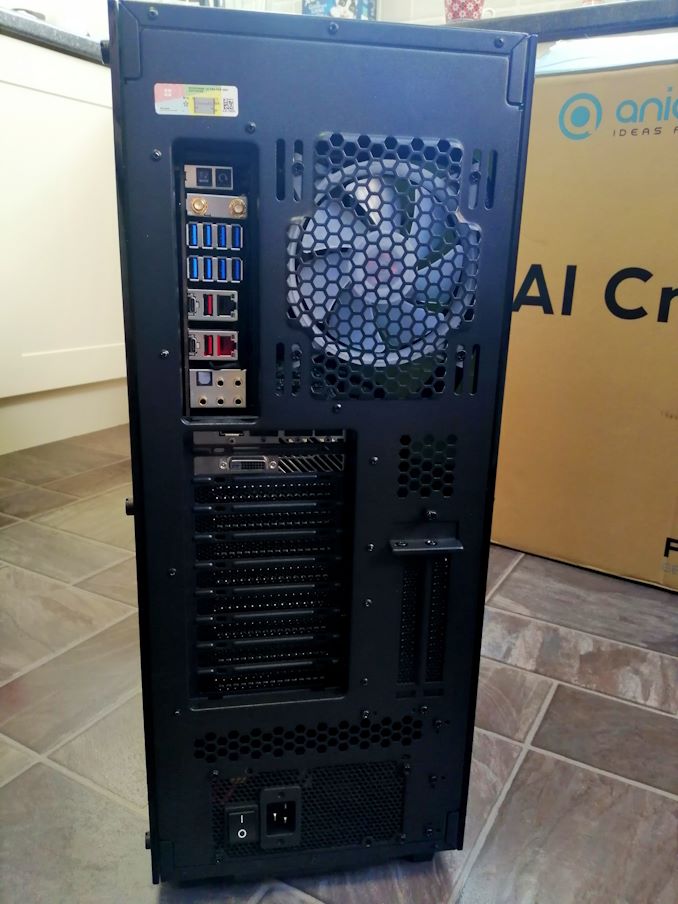
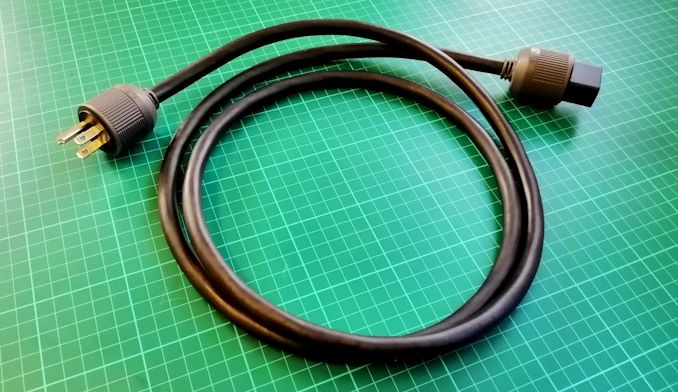
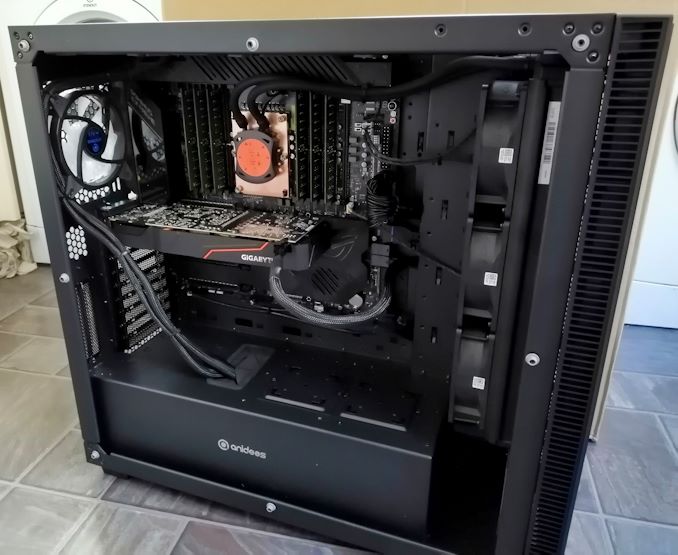
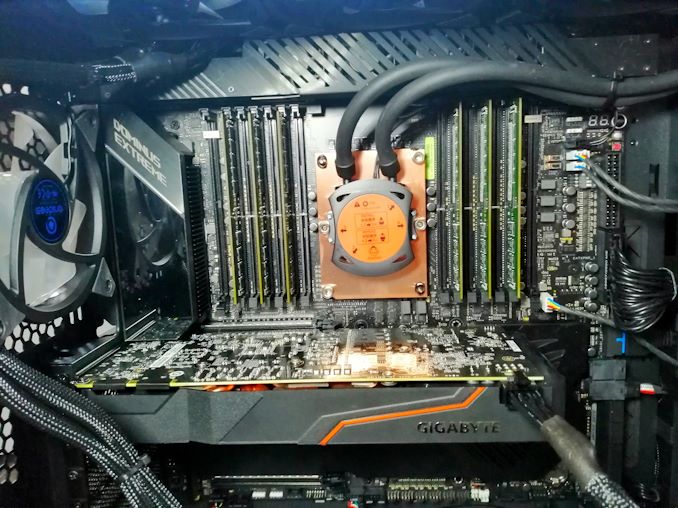

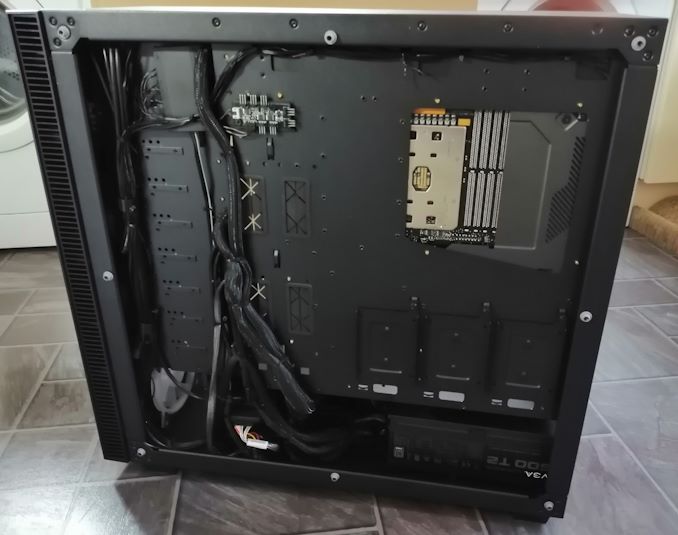
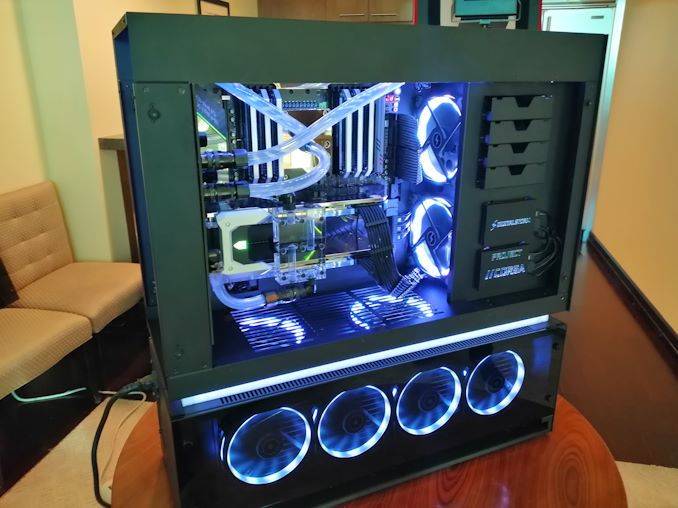








136 Comments
View All Comments
eastcoast_pete - Wednesday, January 30, 2019 - link
@Ian: Thanks for the review. I guess the "lower" price of this 28-core Xeon shows the benefit of having strong competition in the market - without the large Threadrippers, that price wouldn't have come down from the $ 8,000 mark.Two questions: I am still struck by how often the higher-end "consumer" grade CPUs beat the pants off the many-core monsters. Is high single-thread performance still that dominant in the applications in which the 9900K or 2700x lead the pack?
Second, did Intel really recommend to plug this monster directly into a wall outlet? If yes, wow. Guess you need a surge-protected, line-conditioned house line then, so not exactly standard equipment. Having encountered brownouts and voltage spikes, I wouldn't plug even a $ 500 PC straight into an unprotected household socket, never mind a $ 7,000 rig. I guess if that's what they recommend, it doesn't void the warranty when stuff happens.
My other comment is that this chip is really about workstation-type tasks, and while I know that coming up with more workstation-specific test suites is too specialized, that's where these Xeons and the big Threadrippers start making sense.
Regarding gaming: As you also hint at, much of that $ 3,000 budget for the CPU would be better spend on two or more high-end graphics cards (2080 GTX), all liquid cooling, a hand-selected eight core CPU, and a large, ultra-wide aspect fast refresh HDR-capable monitor.
zepi - Wednesday, January 30, 2019 - link
Ian is working in UK. He has most likely something like 230V single phase 80A feed-in to his house, if not 100 or even 120A, depending if he has electric heating or gas.One main fuse for that surely. Then that phase is split to some smaller circuits feeding into separate rooms & sockets etc. probably 8-16A fuses. Some stronger ones (30+A) if he has electric heaters in the taps / shower without using a boiler & heating circuits.
Then another fuse in each wall socket. And most likely a fourth fuse inside the actual cable.
And @230V, the cable "only" needs to support 7A, so it is actually nothing spectacular.
1500W devices are perfectly fine in Europe, mostly because of the 230V voltage. It just makes things much easier.
SaturnusDK - Wednesday, January 30, 2019 - link
Many if not most European households have 3 phase 230V 16A power, so you can power standard 400V appliances.BushLin - Wednesday, January 30, 2019 - link
In the UK a standard wall outlet is rated for 13A. Our kettles are nearly all 3KW. We value our tea and have built our homes around it.eastcoast_pete - Wednesday, January 30, 2019 - link
But then, your kettle doesn't require clean sine wave AC current, and won't suffer much if the voltage drops or spikes. In contrast, an expensive rig like this might. My comment wasn't about overall power need of this setup, but my surprise over the "unfiltered wall socket is fine" instruction from Intel.eastcoast_pete - Wednesday, January 30, 2019 - link
I am quite familiar with the situation in Europe. But, even there, I wouldn't just trust a regular power outlet (220 or 230 V) to provide clean sine power free from interference, voltage drops (brownouts) and voltage spikes, and neither do several friends of mine who live and work in Europe. They also use, at minimum, a good surge protector, and, for expensive systems, a UPS and line conditioner, just like we do here in the States.SaturnusDK - Thursday, January 31, 2019 - link
Surge protection is built into all regulatory fuse boxes so you don't need that in Europe since 2003 unless the building hasn't been updated to the current building code. Also before 2003 it was 220V in Europe and 240V in the UK. Now it's just 230V everywhere. Last there was a registered brown out in the area I live and work was February 1987... almost 32 years ago. In many areas of Europe it's not even worth considering as a risk anymore. You still need an UPS for obvious reasons though.maroon1 - Wednesday, January 30, 2019 - link
At least it is faster and has more consistence performance than 2990WX. Gaming performance also much better without the need to disable cores like you do for 2990WXtamalero - Wednesday, January 30, 2019 - link
I'm still scratching my head on who would buy this thing for "gaming" o_Oalacard - Wednesday, January 30, 2019 - link
Damn Ian you're on a roll with this on the heels of your incredible Intel's 10nm Cannon Lake and Core i3-8121U Deep Dive Review. Do you ever sleep?There's so much talent here that all you guys really should quit working for Purch and start your own independent tech site where the ads are reasonable and not exploitative. I can imagine everyone running straight to it and supporting it. Make it run on small ads and donations and you'd probably make out like kings.
Purch doesn't deserve you, period. Takes your talents elsewhere.